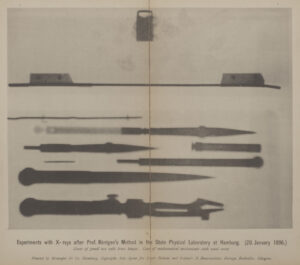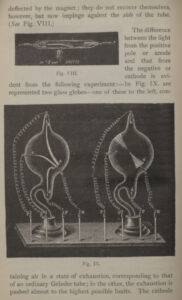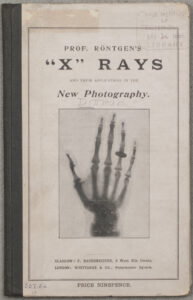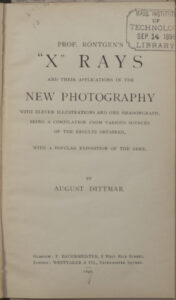When German physicist Wilhelm Röntgen announced his discovery of X-rays at the end of 1895, the mysterious rays and the eerie photographs they took understandably caused quite a stir among both scientists and the public. Röntgen’s photos of balance-weights in a closed box, the chamber of a shotgun, and especially of his wife’s hand with visible bones seemed almost magical.
Röntgen ascertained the existence of X-rays when he was performing experiments using a Crookes tube, a kind of cathode ray tube. Repeating an experiment carried out previously by physicist Philipp Lenard, Röntgen happened to notice that a barium platinocyanide detecting screen — despite being located at a distance beyond that traversable by a cathode ray — was fluorescing. Röntgen christened the unseen rays apparently emanating from the wall of the Crookes tube towards the screen “X-rays.”
In this period before modern understanding of photons, the prevailing theory of light was based on the existence of the “luminiferous ether,” an undetectable medium filling all space and matter through which light and other electromagnetic waves were transmitted. Visible light was thought to consist of transverse vibrations in the ether (vibrations perpendicular to the direction of light). Röntgen hypothesized that X-rays consisted of longitudinal vibrations of the ether. Today, we understand X-rays as the release of potential energy by an atom’s outer electron falling to replace an inner orbital electron dislodged by bombardment from incident electrons.
 This 32-page pamphlet was stamped by the MIT Libraries on September 14, 1896, eight months after news of the marvelous X-rays took the world by storm. August Dittmar starts with a description of basic principles of electricity and of cathode ray tubes, then describes the experiments and observations made by Röntgen, and ends with some discussion of the “shadowgraphs” X-rays can produce and their medical applications, as well as instructions for building a photographic apparatus.
This 32-page pamphlet was stamped by the MIT Libraries on September 14, 1896, eight months after news of the marvelous X-rays took the world by storm. August Dittmar starts with a description of basic principles of electricity and of cathode ray tubes, then describes the experiments and observations made by Röntgen, and ends with some discussion of the “shadowgraphs” X-rays can produce and their medical applications, as well as instructions for building a photographic apparatus.
In 1901, Wilhelm Röntgen was honored for his discovery of X-rays by the awarding of the first Nobel Prize in Physics.


